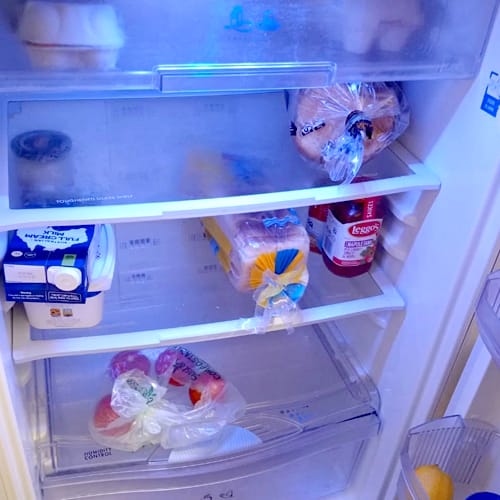Table of contents
Introduction: Why Food Security Matters at Home in the UK
Food in the UK has rarely felt as costly—or as uncertain—as it does right now. Rising food inflation in the UK and growing dependence on imports make household food security UK more relevant than ever.

Why Food Security Matters
- In 2023, food inflation spiked to 19% year-on-year – the highest in 45 years.
- Prices have dipped slightly since, but they remain well above pre-2022 levels.
- The UK produces only about 17% of its fruit and 55% of its vegetables, leaving households reliant on imported produce from climate-stressed regions.
This mix of higher prices and fragile supply chains makes it harder for families to afford nutritious food and puts pressure on everyday household budgets.
Building Household Food Security
This is where food security at home UK becomes essential. By making a few simple changes—like growing herbs on a windowsill, baking homemade bread, or preserving seasonal produce—you can:
- Reduce weekly shopping costs
- Improve household resilience
- Gain more control over your food supply
It’s not about becoming fully self-sufficient. Instead, it’s about building a buffer against price hikes and supply shortages while making food more affordable and reliable.
Who This Guide Is For
Whether you’re a busy parent looking to stretch the family food budget, or a city renter, making the most of a balcony or sunny windowsill, there are practical, down-to-earth strategies to strengthen UK food resilience at home.
What This Guide Covers
- What food security really means
- Why the UK is particularly exposed
- Everyday steps households can take to grow, cook, and save
What Food Security Really Means
Food security isn’t just a global concept—it directly affects households across the UK. The FAO definition of food security is simple: all people, at all times, should have physical and economic access to enough safe, nutritious food for an active and healthy life. For families dealing with rising food prices, this breaks down into four practical pillars you can apply at home.
The FAO four pillars of food security framework helps explain how availability, access, utilization, and stability all shape household resilience.
Pillar 1: Availability
- National level: Ensuring enough food is produced or imported to meet demand.
- Household level: Having food you can actually reach—stocked cupboards, homegrown produce, or frozen meals ready to use.
- Example: Emma’s family grows salads and keeps jars of chutney, so they’re not relying only on supermarkets.
Pillar 2: Access
- National level: Food may be available, but can everyone afford it?
- Household level: Rising food inflation in the UK makes economic access a real challenge. Having the money, time, and means to get food—or growing some yourself—eases the pressure.
- Example: Mark grows herbs and salads on his balcony, trimming his weekly shop.
Pillar 3: Utilization
- National level: Making sure food is safe, nutritious, and used well.
- Household level: Cooking skills, clean water, and proper storage turn raw ingredients into healthy meals.
- Example: Emma batch cooks and freezes dinners, saving money while cutting food waste.
Pillar 4: Stability
- National level: A food system must be steady over time.
- Household level: Stability comes from building buffers—preserving harvests, batch cooking, or planting perennials that return each year.
- Example: Mark relies on his freezer stash of soups and curries when budgets are tight, avoiding costly takeaways.
In short: If any of these four pillars—availability, access, utilization, or stability—fail, households risk food insecurity. By linking these global ideas to everyday habits, UK families can see how simple steps like growing, cooking, and preserving food at home build resilience and improve household food security UK.
Why the UK Is Exposed
UK supermarket shelves may look full, but the system behind them is more fragile than it seems. Because the country depends so heavily on imports, the UK is vulnerable to climate change, global price shocks, and rising costs at home. These pressures show why household food security UK is more important than ever.
Import Dependence
- Overall production: The UK produces only 60–62% of the food it consumes.
- Fruit and veg gap: Just ~17% of fruit and ~55% of vegetables are grown domestically.
- Reliance on imports: Nearly half of our fruit and vegetables come from overseas, mainly Spain and Morocco—regions already hit by climate stress.
According to the latest Defra Food Security Index and UK Food Security Report 2024, the UK remains heavily reliant on imports for fruit and vegetables, highlighting why building resilience at home matters.
Climate Impacts
- Changing harvests: In 2020, a wet spring caused one of the lowest cereal harvests in decades, while 2019 produced one of the best.
- Imported shortages: Heatwaves and droughts in Spain and Morocco triggered tomato, lettuce, and pepper shortages in UK shops.
- Domestic risks: Soil degradation and water shortages threaten long-term UK yields.
Supply Chain Fragility
- Just-in-time model: UK supermarkets keep minimal stock buffers, relying on rapid turnover.
- Recent shocks: COVID-19, Brexit labour shortages, and the energy crisis all revealed how fragile the system is.
- Rising costs: Fertiliser, transport, and energy price hikes squeeze farmers and raise retail prices.
Global Volatility
- Global conflicts: The Ukraine war pushed up global grain and cooking oil prices.
- Energy impacts: Price spikes forced fertiliser plants and greenhouse growers to scale back.
- Currency swings: When the pound weakens, imported food becomes more expensive for UK households.
Why This Matters
- For Emma’s family, rising fruit and veg prices make it harder to keep meals affordable and healthy.
- For Mark, even a short-term shortage or price rise can throw his tight budget off track.
In short: The UK food system is exposed to climate, economic, and supply chain shocks. That’s why taking small, practical steps toward food security at home UK is a smart move for every household.
Practical Household Playbook
Food security at home UK doesn’t require acres of land or endless spare time. By building a few smart habits—like growing high-value crops, trying indoor gardening, baking, preserving, and cooking more efficiently—you can save money, cut waste, and boost household resilience without overcomplicating life.
High-Value Crops for Maximum Savings
- Focus on foods that are expensive to buy but cheap to grow: herbs, salad leaves, peppers, climbing beans, garlic, and soft fruits like raspberries or currants.
- A £1 seed packet of salad can replace dozens of supermarket bags.
- A berry bush often pays for itself in two summers and keeps fruiting for years.
- Emma’s family treats salad sowing as a fun weekend job with the kids, while Mark uses a balcony trough or a few pots.
For step-by-step tips on crops that thrive in UK conditions, check out the RHS Grow Your Own advice. Not sure what to sow and when? Our Seasonal planting calendar UK makes it easy to plan crops that save money throughout the year.
Indoor Growing for Year-Round Access
- Herbs and microgreens thrive on sunny windowsills, while compact hydro kits keep harvests going through winter.
- Quick wins include basil, coriander, rocket, and cut-and-come-again mixes.
- Emma sprinkles homegrown herbs into family meals, while Mark grows microgreens indoors to reduce his weekly shop.
If you’re curious about extending the growing season indoors, our LED grow lights beginner guide UK]breaks down how to use them cost-effectively.
Bread & Baking
- Baking bread at home saves money and tastes better. An 800g loaf costs around £0.85–£1.20 at home, compared with £1.10–£2.50 in the shops.
- Breadmakers make the process easier and often more energy-efficient.
- Mark enjoys experimenting with sourdough in his oven, while Emma uses her breadmaker for the family’s daily loaves.
Preserve and Store
- Make food last longer and cut waste by:
- Freezing surplus veg and herbs.
- Pickling or fermenting seasonal gluts.
- Dehydrating fruit, tomatoes, or herbs (try a DIY solar food dehydrator).
- The average UK family wastes around £700 of edible food each year—preserving helps reclaim much of that.
- Emma turns courgette gluts into chutney, while Mark makes small-batch fridge pickles.
Households in the UK throw away millions of tonnes of edible food each year—WRAP reduce food waste offers practical tips to cut waste and save money.
Energy & Resource Resilience
- Smarter cooking saves both energy and money:
- Batch cook when the oven’s already on.
- Use energy-efficient appliances like air fryers, pressure cookers, or slow cookers.
- Everyday tricks—like putting lids on pans or boiling water in the kettle first—add up quickly.
- Composting and wormeries enrich your soil, while water butts help with irrigation.
- Emma leans on freezer meals from big batch cooks, and Mark relies on slow cooker stews for affordable, filling dinners.
The Energy Saving Trust cooking comparisons show how tools like slow cookers, air fryers, and microwaves can use far less energy than ovens, helping households lower bills. Turning kitchen scraps into compost is simple—our Composting and wormery guide shows you how to cut waste and improve soil fertility at the same time.
Key takeaway: Start small—grow herbs on a windowsill, bake one loaf a week, or freeze leftovers. Over time, these everyday habits stack up into meaningful savings and stronger household food security UK.
Case Mini-Budgets: What You Can Save
Numbers make household food security UK easier to picture. Here are three clear examples that show how small, everyday choices can cut costs and build long-term household resilience.
Windowsill Herb Kit (£50 setup)
- What you need: A trough or pots, compost, and seed packets such as basil, coriander, parsley, or mint.
- Ongoing cost: Minimal—just the occasional compost top-up and water.
- Annual yield: Equivalent to £120–£150 worth of supermarket herbs.
- Who benefits: Perfect for Mark in his flat—he saves money on fresh herbs and avoids food waste by snipping only what he needs.
4m² Salad Bed (Garden or Allotment)
- What you need: A raised bed or about four square metres of soil, plus seed packets for lettuce, rocket, spinach, and radish.
- Ongoing cost: Around £10–15 per year for seeds and compost.
- Annual yield: Fresh greens valued at £250–£300 from spring to autumn.
- Who benefits: Ideal for Emma’s family—the kids help sow and harvest, providing a steady supply of salads while trimming the food bill.
Breadmaker Use (Weekly Loaves)
- What you need: A breadmaker (£80–£120 upfront), plus strong flour, yeast, salt, and water.
- Ongoing cost: Around 85p–£1.20 per loaf, energy included.
- Annual yield: Replacing three £1.50 shop loaves per week saves £45–£75 annually after the machine pays for itself.
- Who benefits: Great for both Emma—who keeps her family stocked with daily bread—and Mark, who enjoys experimenting with sourdough and flavoured loaves.
FAQs: Common Questions About Household Food Security
Yes—but it depends on what you choose to grow. Focus on high-value crops such as herbs, salads, and soft fruit. Skip cheap staples like potatoes, carrots, or onions unless you want the freshness or enjoy the process. For most households, the best savings come from herbs and greens that are expensive in shops.
Plenty! Herbs like basil, parsley, and coriander thrive in containers. Add cut-and-come-again salads, chillies, strawberries, or compact tomatoes. Indoors, microgreens are quick, affordable, and high return—making them a smart option for renters.
For regular baking, breadmakers are usually more energy-efficient and convenient, especially for families. Ovens make sense if you’re batch-baking or already cooking something else at the same time. Either way, both beat shop-bought bread on cost and quality.
Preserve it. Freeze extra produce, pickle or ferment seasonal gluts, or dehydrate fruit and herbs. Batch cooking also helps—turning excess into soups, sauces, or chutneys. Reducing waste is one of the fastest ways to save money and improve UK food resilience at home.
Sometimes. Efficient LED grow lights can keep herbs and salads thriving through dark winters. However, balance the energy cost against shop prices—often, a sunny windowsill is enough. For renters in small flats, compact LED kits extend growing seasons and boost household food security UK.
Key takeaway: Most households can save money and strengthen food security at home UK with a few realistic steps. Whether you have a garden, a balcony, or just a sunny window, building household resilience is within easy reach.
Conclusion: Small Steps, Big Impact
Household food security UK doesn’t mean going fully self-sufficient or producing everything you eat. Instead, it’s about building resilient food systems at home and saving money with a handful of repeatable, practical habits.
Four Simple Ways to Build Food Security
- Grow high-value crops like herbs, salads, and berries to reduce supermarket bills.
- Use a breadmaker or oven to bake loaves that are cheaper, healthier, and fresher.
- Preserve food at home to avoid waste and create a buffer for leaner months.
- Adopt energy-efficient cooking habits to make your budget go further.
Why It Matters
Whether you’re a busy parent like Emma or an urban renter like Mark, these actions make food more affordable and reliable. One small change—like sowing herbs or freezing leftovers—might feel minor, but combined, they strengthen household resilience and improve long-term savings.
👉 Start this week: plant a pot of herbs, bake a single loaf, or freeze leftovers instead of binning them. These quick wins add up to lasting resilience and stronger food security at home UK.





